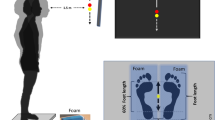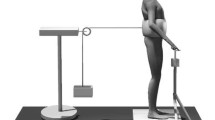Abstract
Balance stability is important for human beings. Previous studies have shown that mechanical noise applied to the soles of the feet via vibrating insoles can improve human balance control. In this study we designed an experimental procedure called standard aiming target test to quantitatively evaluate the effect of vibrating insole on specific task of aiming during standing. Ten subjects were asked to aim at a target sheet using laser gun, and the traces of their aimed light spots and the center of pressure (COP) were recorded simultaneously. The same test was repeated twice for each individual with vibrating insole off and on, respectively. To assess dynamic patterns in aiming spot and COP signals, we calculated the entropies in the magnitude increments of both signals at different time scales, i.e., multiscale entropies (MSE).We found that the vibrating insole significantly improved the aiming performance and led to increased entropy in the fluctuations of aiming spot displacement over a range of time scales from 0.001 to 0.05 s. In addition, subjects with larger entropies in the aiming spot fluctuations had better aiming performances. Furthermore, we found that the entropy of the light spot signal was positively correlated with the entropy of the magnitude time series of COP fluctuations. These results suggest that vibrating insoles is beneficial for the complex postural control process during target aiming, possibly via their dynamic influences on the balance regulatory system.






Similar content being viewed by others
References
Priplata AA, Niemi JB, Salen M et al (2002) Noise enhanced human balance control. Phys Rev Lett 89:238101
Liu W, Lipsitz LA, Montero-Odasso M et al (2002) Noise-enhanced vibrotactile sensitivity in older adults patients with stroke, and patients with diabetic neuropathy. Arch Phys Med Rehabil 83:171–176
Priplata AA, Niemi JB, Harry DJ et al (2003) Vibrating insoles and balance control in elderly people. Lancet 362:1123–1124
Ajitkumar PM, Matthew JF, Igor SK et al (2011) Improving balance function using vestibular stochastic resonance: optimizing stimulus characteristics. Exp Brain Res 210:303–312
Browne J, O’Hare N (2000) A quality control procedure for force platforms. Physiol Meas 21:515–524
Ashkenazy Y, Ivanov PC, Havlin S et al (2001) Magnitude and sign correlations in heartbeat fluctuations. Phys Rev Lett 86:1900–1903
Hu K, Scheer FA, Ivanov PC et al (2007) The suprachiasmatic nucleus functions beyond circadian rhythm generation. Neuroscience 149:508–517
Hu K, Scheer FA, Buijs RM et al (2008) The endogenous circadian pacemaker imparts a scale-invariant pattern of heart rate fluctuations across time scales spanning minutes to 24 hours. J Biol Rhythm 23:265–273
Costa M, Goldberger AL, Peng CK (2002) Multiscale entropy analysis of complex physiologic time series. Phys Rev Lett 89(6):068102–068104
Brad M, Costa MD, Kun H et al (2010) Physiological complexity and system adaptability: evidence from postural control dynamics of older adults. J Appl Physiol 109:1786–1791
Linda BT, Roberta AN (1996) Use of the Berg balance test to predict falls in elderly persons. Phys Ther 76(6):576–583
Petersen RC, Smith GE, Waring SC (1999) Mild cognitive impairment: clinical characterization and outcome. Arch Neurol 56:303–308
Chesnokov YV (2008) Complexity and spectral analysis of the heart rate variability dynamics for distant prediction of paroxysmal atrial fibrillation with artificial intelligence methods. Artif Intell Med 43:151–165
Trunkvalterova Z, Javorka M, Tonhajzerova I (2008) Reduced short-term complexity of heart rate and blood pressure dynamics in patients with diabetes mellitus type 1: multiscale entropy analysis. Physiol Meas 29:817–828
Hung CH, Jiang BC (2009) Multiscale entropy approach to physiological fatigue during long-term web browsing. Hum Factor Ergon Man 19(5):478–493
Takatsugu A, Keiichi K, Daichi N et al (2010) How does stochastic resonance work within the human brain?—Psychophysics of internal and external noise. Chem Phys 375:616–624
Author information
Authors and Affiliations
Corresponding author
Rights and permissions
About this article
Cite this article
Zhou, J., Bao, D., Zhang, J. et al. Noise Stimuli Improve the Accuracy of Target Aiming: Possible Involvement of Noise-Enhanced Balance Control. Exp Mech 54, 95–100 (2014). https://doi.org/10.1007/s11340-013-9728-3
Received:
Accepted:
Published:
Issue Date:
DOI: https://doi.org/10.1007/s11340-013-9728-3




